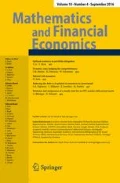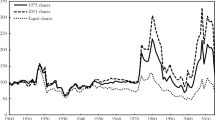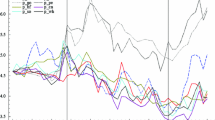Abstract
A new methodology is laid out for the modeling of commodity prices, it departs from the ‘standard’ approach in that it makes a definite distinction between the analysis of the short term and long term regimes. In particular, this allows us to come up with an explicit drift term for the short-term process whereas the long-term process is primarily driftless due to inherent high volatility of commodity prices excluding an almost negligible mean reversion term. Not unexpectedly, the information used to build the short-term process relies on more than just historical prices but takes into account additional information about the state of the market. This work is done in the context of copper prices but a similar approach should be applicable to wide variety of commodities although certainly not all since commodities come with very distinct characteristics. In addition, our model also takes into account inflation which leads us to consider a multi-dimensional system for which one can generate explicit solutions.











Similar content being viewed by others
Notes
The inclusion or not of a mean reversion term in the long-term process will be taken up in the section devoted to the long-term process.
In the Pilipovic model, prices are modeled by a system of two stochastic differential equations: the first one for the spot price, which is assumed to mean-revert toward the equilibrium price level, and the second for the equilibrium price level, which is supposed to follow a log-gaussian distribution,
$$\begin{aligned} dS_t&= \alpha \left( L_t - S_t\right) dt + \sigma S_t dw_t\\ dL_t&=\mu L_t dt + L_t yi dz_t \end{aligned}$$We also implemented the Phillips–Perron test but the results obtained were the same as for the ADF test.
References
Andersson, H.: Are commodity prices mean reverting? Appl. Financ. Econ. 17(10), 769–783 (2007)
Barlow, M.T.: A diffusion model for electricity prices. Math. Financ. 12(4), 287–298 (2002)
Bessembinder, H., Coughenour, J.F., Seguin, P.J., Smoller, M.: Mean reversion in equilibrium asset prices: evidence from the futures term structure. J. Financ. 50(1), 361–375 (1995)
Chen, Y.-C., Rogoff, K., Rossi, B.: Can exchange rates forecast commodity prices? Q. J. Econ. 125(3), 1145–1194 (2010)
Cretì, A., Villeneuve, B.: Commodity storage with durable shocks: a simple markovian model. U. Paris-Dauphine, Technical report, CEREMADE (2013)
Dixit, A.K.: The Art of Smooth Pasting. London School of Economics and Political Science, London (1992)
Dixit, A.K., Robert, S.: Investment Under Uncertainty. Princeton University Press, Pindyck (1994)
Ekeland, I., Lautier, D., Villeneuve, B.: A simple equilibrium model for a commodity market with spo trades and future contracts. U. Paris-Dauphine, Technical report, CEREMADE (2013)
Engel, E., Valdes, R.: Prediciendo el precio del cobre: Mas alla del camino aleatorio? Universidad de Chile (2001)
Gibson, R., Schwartz, E.S.: Stochastic convenience yield and the pricing of oil contingent claims. J. Financ. 45(3), 959–976 (1990)
Hilliard, J.E., Reis, J.A.: Valuation of commodity futures and options under stochastic convenience yields, interest rates and jump diffusions in the spot. J. Financ. Quant. Anal. 33(1), 61–86 (1998)
Hull, J.: Options, Futures, and Other Derivatives, 7th edn. Prentice Hall, Boston (2008)
Miltersen, K.R., Schwartz, E.S.: Pricing of options on commodity futures with stochastic term structures of convenience yields and interest rates. J. Financ. Quant. Anal. 33(1), 33–59 (1998)
Nielsen, M.J., Schwartz, E.S.: Theory of storage and the pricing of commodity claims. Rev. Deriv. Res. 7, 5–24 (2004)
Pilipovic, D.: Energy Risk: Valuing and Managing Energy Derivatives. McGraw-Hill, New York (2007)
Ribeiro, D.: Models for the price of a storable commodity. Ph.D. thesis, University of Warwick (2004)
Royset, J., Wets, R.J.-B.: Epi-splines and exponential epi-splines: Pliable approximation tools. Math. Programm. (submitted) (2014)
Schwartz, E.S.: The stochastic behavior of commodity prices: Implications for valuation and hedging. J. Financ. 52(3), 923–973 (1997)
Schwartz, E.S.: Valuing long-term commodity assets. Financ. Manag. 27(1), 57–66 (1998)
Schwartz, E.S., Smith, J.E.: Short term variations and long term dynamics in commodity prices. Manag. Sci. 46(7), 893–911 (2000)
Uhlenbeck, George E., Ornstein, Leonard: On the theory of brownian motion. Phys. Rev. 36, 823–841 (1930)
Ulloa, A.: Tendencia y volatilidad del precio del cobre. In: Meller, P. (ed.) Dilemas y debates en torno al cobre, Chapter 7. Dolmen, Santiago (2002)
Wets, R.J.-B., Bianchi, S.W., Yang, L.: Serious Zero Curves. EpiRisk Research LLC, El Cerrito (2002)
Wets, R.J.-B., Bianchi, S.W.: Term and volatility structure, handbook of assets and liability management. In: Zenios, S.A., Ziemba, W. (eds.) Handbook of Aset and Liability Management, pp. 26–68. Elsevier, Amsterdam (2006)
Williams, J.C., Wright, B.D.: Storage and Commodity Markets. Cambridge University Press, Cambridge (1991)
Acknowledgments
This project was started while the first author was visiting the Centro de Modelamiento Matematico and Systemas Complejos de Ingeneria, Universidad de Chile. His research was supported in part by the U. S. Army Research Laboratory and the U. S. Army Research Office under Grant number W911NF-10-1-0246. The research of the second author was financed by Complex Engineering Systems Institute (ICM:P-05-004-F, CONICYT: FBO16) and Fondecyt Project 1120318.
Author information
Authors and Affiliations
Corresponding author
Electronic supplementary material
Below is the link to the electronic supplementary material.
Appendix
Appendix
1.1 Appendix 1: Approximate solution of the long-term process
The solution of the long-term process is given by,
where \(r_i(t,s)=-\left[ \mu _i+\frac{1}{2}\sum _{j=1}^J b_{ij}^2\right] (t-s)+\sum _{j=1}^J b_ij \left( w_j^t-w_j^{s}\right) \). We are going to approximate this solution replacing the term \(\mu _i \upsilon _i \int _0^t e^{r_i(t,s)ds}\) by its expectation. Then,
But noting that \(\left( w_j^t-w_j^{s}\right) \) is a gaussian process with mean 0 and variance \((t-s)\) we know that,
Finally, we can approximate the solution of the long-term process to,
1.2 Appendix 2: Parameter estimation of the short-term process
The SDE that governs the short term process can be written as,
where \(S_i^t=\ln x_i^t\). Then, we know that the \(dS_i^t\) follows a gaussian distribution with the following properties (see Dixit [6] and Hull [12]):
Considering the discrete case we have,
Then, the easiest method to estimate the parameters of this model is using the fact that \(S_i^t=\ln x_i^t\) and historical prices in such a way that,
Another way to estimate these parameters is recalling that, for \(i\in \{p,r\}\)
where \(\mu _i\) is the drift and \(x_i^0\) the initial value of index \(i\).
Then, we estimate \(\mu _i, \; i \in \{p,r\}\) and the initial state denoted by \(\theta _i, \; i \in \{p,r\}\). Estimating the initial state is very important because in most applications is used the actual spot price as initial condition, forgetting that this also has noise as it is a random variable.
Finally, assuming that the errors in the observations (\(x_i^t\)) come from white noise around the drift term \(\mu _i t\), one has
The main idea of this approach is to minimize the error associated to the estimation. For doing so, we are going to minimize \(\sum _{t\in T} |\varepsilon _i^t|^2\), i.e.,
Differentiating with respect to \(\theta _i\) and \(\mu _i\) we get,
Setting these derivatives equal to 0 we obtain,
Solving the system and denoting \(a=\sum _{t\in T} t\) and \(b=\sum _{t\in T} t^2\) we obtain, for \(i\in \{p,r\}\)
where \(\eta \) is the number of observation, i.e., if we consider just the historical information of the last 12 months \(\eta =13\).
Covariance matrix To estimate the covariance matrix with this method we know that,
Assuming that observations are corrupted by a white noise \(\varepsilon _{kl}^t\) that affects \(|t|\sum _{j\in \{p,r\}}b_{kj}b_{lj}\) and recalling that \(\hat{x}_k^t=\hat{\theta }_k e^{\hat{\mu }_k|t|}\), i.e., for \(t=-12,\ldots ,0\),
Then, seeking estimates that minimize \(\sum _t |\varepsilon _{kl}^t|^2\), one obtains the estimate \(\hat{\beta }_{kl}\) for \(\sum _{j\in \{p,r\}}b_{kj}b_{lj}\):
Thus, the estimate for \(cov\left( x_p^{t}, x_r^{t}\right) \) is,
and the variance, for \(k\in \{p,r\}\),
Rights and permissions
About this article
Cite this article
Wets, R.JB., Rios, I. Modeling and estimating commodity prices: copper prices. Math Finan Econ 9, 247–270 (2015). https://doi.org/10.1007/s11579-014-0140-2
Received:
Accepted:
Published:
Issue Date:
DOI: https://doi.org/10.1007/s11579-014-0140-2




